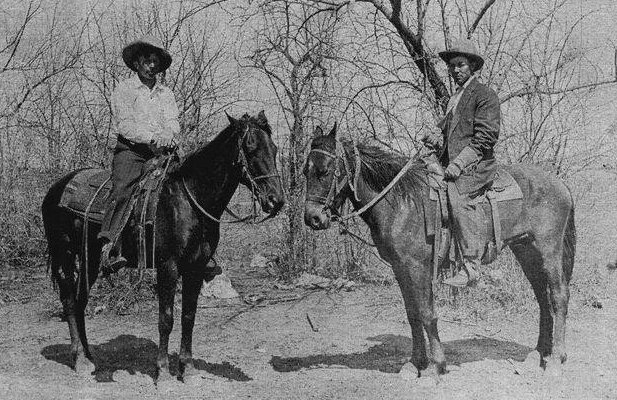
Barber County Kansas

 |
Barber County Kansas |
 |

Marion Francis McLain, at left, with Lewis Maple Hastings, photo taken
before 1916.
Photo courtesy of Brenda McLain.
The Story of Lewis Maple Hastings
by Gloria Miller Carpenter
December 2004
Lewis Maple Hastings was born March 13, 1891, in Beaver County, in the Oklahoma panhandle. He was the son of Millard Filmore Hastings and his wife Charlotte Martin Hastings. He had five sisters: Emma Ellen, Lucy Jane, Maudy May, Irma Irene and Charlotte Carmen; and two brothers: William Bryan and Noah Webster.
When Lewis was growing up, life was rough. The family lived in a "dug out" (sort of a cave) in Oklahoma, and Oklahoma was known as "Indian Territory" in those days before it was a state. Lewis's grandfather and his Garten and Martin uncles had participated in a run for land in Oklahoma. The Oklahoma "Sooners" are named for the men who, on a given signal, galloped out across the plains to claim a piece of land. To receive Oklahoma land from the government, people had to agree to live on the land and improve it. Some of the men built cabins and brought their families there, then, leaving their wives and children on the land, went back home (in this case, Kansas) to work for the money they needed to improve the land. One uncle went back to Barber County, Kansas, each year to pick up buffalo bones to sell. It's hard to imagine that there were so many buffalo bones available, and that they were of enough value to bother collecting them, but in those days ground-up buffalo bones were used for fertilizer, and bone at that time was used for buttons, and other things that later were made of plastic.
Lewis's parents were very poor. The father, Millard Filmore Hastings, usually called "Phil," did not work regularly and was gone from home for months at a time. He suffered from wanderlust and was always looking for a chance to get rich quick. Well, he did not get rich, either quickly or slowly. The family hardly had enough to eat and their shelter was barely adequate.
When Lewis was about 12, his family moved to Texas. They lived in Canadian, a town in Hemphill County. There his mother, Charlotte usually called "Lottie") ran a hotel. It was not very large, and though they called it the "Lone Star Hotel," we might call it a boarding house. As it was near the railroad, most of the hotel guests were travelers or railroad crewmen. Each morning the Hastings children went to the train tracks to pick up "clinkers," the pieces of coal that fell off the trains as they went through. Coal was a major source of heat in those days, and tons of it traveled across the country on trains. Well, the Hastings children picked up what coal they could find each day and brought it back to be burned in the stoves at the hotel. Coal and wood were the fuels used for heating, for providing hot water, and for cooking. It took a lot of work to have an adequate amount of these fuels to keep the hotel going. There were also other jobs to be done, such as cleaning the rooms everyday, and polishing the glass chimneys on the oil lamps they used for light.
As Phil was so seldom there, Lottie was responsible for providing for her family, and the children had to help. She not only took in boarders, but also served meals to other paying customers. All the children, especially the girls, had to help in the kitchen. They all cooked and served and cleaned up after meals. But Lewis was not content with working in the hotel. He loved being outdoors, and he loved horses. He had ridden a horse since early childhood, and he thought of himself as a cowboy. He decorated a pair of leather cowboy cuffs, hand tooling them with ornamental and personal designs. He carved his initials "L. M. H.," on each cuff, and the place he lived, "Canadian, Tx." He also carved and stamped a cross, star, horse, diamond, heart, vines, and a horseshoe for good luck.
Throughout his childhood, Lewis often lived for periods of time with his grandmother, Mary Elzira (Kern) Hastings, at her home near Sun City, Kansas. Mary Elzira, along with two of her sons, had a ranch there. Lewis was happy helping around the ranch, and for entertainment, he would ride into Medicine Lodge, the county seat of Barber County, about 20 miles east. As he rode along, he went past Lake City, and the homestead of Henderson Martin, his mother's father, and also past the Sun City and Lake City cemeteries, where many of his relatives were buried. He felt at home in Kansas and loved the ranch there.
When Lewis was old enough to leave home and be on his own, of course he wanted to work with horses on a ranch. In 1913 he went to Omaha, Nebraska, where he stayed for a while with his sister, Emma Hastings Miller, and her family, including her sons, LeRoy and Eugene, and her daughter, Carolyn. Emma's husband, Arthur Dewitt Miller, made his living working with horses. He kept teams of work horses that he rented out for jobs like road grading and clearing land for construction, and he also used the teams to pull sleighs for sleigh rides in the winter.
Then in 1916, Lewis traveled on west looking for a place to work. He found a job near Boise, then known as "Boise City", which was a rugged frontier territory in those days. The next year, on April 7, 1917, when he was just 27 years old, Lewis died. Family tradition has it that he was kicked by a horse.
Lewis's body was taken back to Sun City for burial. Funeral services were held at the cemetery near the road to Medicine Lodge. The Reverend J. P. Woods conducted the ceremony, and many of Lewis's friends and family gathered to say their last farewells. His grandmother, Mary Elzira, was grief-stricken at the loss of the young man who had spent many a happy day with her on the ranch. When she died, less than a year later, she was buried near him in the family plot at the Sun City cemetery.
One of the few possessions Lewis owned at the time of his death was the set of cowboy cuffs he had decorated years earlier. The cuffs were eventually given to his sister, Emma, and then to her son, Eugene, and then to his daughter, Gloria.
Now I am passing the cuffs on to Dylan Miller, who also loves horses. I hope they will be a reminder to him of his family traditions and of his great-great uncle, Lewis Maple Hastings.
Died: Mrs. Jane Martin, wife of Henderson Martin, died of malaria fever at their residence east of this city last Saturday and was buried Sunday in the cemetery at this place. Mr. Martin had recently built a new residence and was surrounding himself with the comforts and conveniences of a pleasant home. Mrs. Martin leaves a husband and seven children.
Also see:
Homer Hastings, uncle of Lewis Maple Hastings.
Mary Eliza (Kern) Hastings, grandmother of Lewis Maple Hastings.
Sunnyside Cemetery, Sun City, Kansas.
Thanks to Gloria Miller Carpenter for the above story, and to Kim Fowles for forwarding it for use on this site.